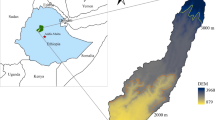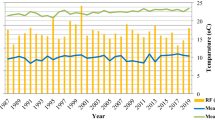Abstract
Land degradation due to erosion is one of the most serious environmental problems in China. To reduce land degradation, the government has taken a number of conservation and restoration measures, including the Sloping Land Conversion Program (SLCP), which was launched in 1999. A logical question is whether these measures have reduced soil erosion at the regional level. The objective of this article is to answer this question by assessing soil erosion dynamics in the Zuli River basin in the Loess Plateau of China from 1999 to 2006. The MMF (Morgan, Morgan and Finney) model was used to simulate changes in runoff and soil erosion over the period of time during which ecological restoration projects were implemented. Some model variables were derived from remotely sensed images to provide improved land surface representation. With an overall accuracy rate of 0.67, our simulations show that increased ground vegetation cover, especially in forestlands and grasslands, has reduced soil erosion by 38.8% on average from 1999 to 2006. During the same time period, however, the change in rainfall pattern has caused a 13.1% ± 4.3% increase in soil erosion, resulting in a net 25.7% ± 8.5% reduction in soil erosion. This suggests that China’s various ecological restoration efforts have been effective in reducing soil loss.






Similar content being viewed by others
References
Bekele EG, Nicklow JW (2007) Multi-objective automatic calibration of SWAT using NSGA-II. Journal of Hydrology 341:165–176
Besler H (1987) Slope properties, slope processes and soil erosion risk in the tropical rain forest of Kalimantan Timur (Indonesian Borneo). Earth Surface Processes and Landforms 12:195–204
Chen RS, Kang ES, Yang JP, Zhang JS (2003) Simulation of water resources transformation in the midstream area of the Hei River Basin. Journal of Glaciology and Geocryology 25(5):566–573 (in Chinese)
De Jong SM (1994) Derivation of vegetative variables from a landsat tm image for modelling soil erosion. Earth Surface Processes and Landforms 19(2):165–178
De Jong SM, Paracchini ML, Bertolo F, Folving S, Megier J, De Roo APJ (1999) Regional assessment of soil erosion using the distributed model SEMMED and remotely sensed data. Catena 37:291–308
Donohue RJ, Roderick ML, McVicar TR (2007) On the importance of including vegetation dynamics in Budyko’s hydrological model. Hydrology and Earth System Sciences 11:983–995
Felix-Henningsen P, Morgan RPC, Mushala HM, Richson RJ, Scholten T (1997) Soil erosion in Swaziland: A synthesis. Soil Technology 11(3):319–329
Feng Z, Yang Y, Zhang Y, Zhang P, Li Y (2005) Grain-for-green policy and its impacts on grain supply in West China. Land Use Policy 22(4):301–312
Govindaraju RS, Reddi LN, Kasavaraju SK (1995) A physically based model for mobilization of kaolinite particles under hydraulic gradients. Journal of Hydrology 172:331–350
Guerschman JP, Hill MJ, Renzullo LJ, Barrett DJ, Marks AS, Botha EJ (2009) Estimating fractional cover of photosynthetic vegetation, non-photosynthetic vegetation and bare soil in the Australian tropical savanna region upscaling the EO-1 Hyperion and MODIS sensors. Remote Sensing of Environment. 113:928–945
Hessel R, Jetten V, Liu B, Zhang Y, Scolte Jannes (2003) Calibration of the LISEM model for a small Loess Plateau catchment. Catena 54(1–2):235–254
Kirkby MJ (1976) Hydrological slope models: the influence of climate. In: Derbyshire E (ed) Geomorphology and climate. Wiley, London, pp 247–267
Knijff JMVD, Jones RJA, Montanarella L (1999) Soil erosion risk assessment in Italy. Space Application Institute, European Soil Bureau 25–26
Li CB (2006) Research of distributed hydrologic modeling in a typical large scale watershed in Longxi Loess Plateau of China. PhD Dissertation, Lanzhou University, pp 52–56 (In Chinese)
Li Y, Poesen J, Yang J, Fu B, Zhang J (2003) Evaluating gully erosion using 137Cs and 210Pb/137Cs ratio in a reservoir catchment. Soil and Tillage Research 69(1–2):107–115
Li CB, Feng ZD, Ma JZ, Wei GX (2008) Study on spatiotemporal resolution for the regional distributed hydrological simulation. Arid Zone Research 25(2):169–173 (in Chinese)
Liu J, Diamond J (2008) Revolutionizing China’s environmental protection. Science 319:37–38
McVicar TR, Jupp DLB (1998) The current and potential operational uses of remote sensing to aid decisions on drought exceptional circumstances in Australia: a review. Agricultural Systems 57:399–468
McVicar TR, Li LT, Van Niel TG, Zhang L, Li R, Yang QK, Zhang XP, Mu XM, Wen ZM, Liu WZ, Zhao YA, Liu ZH, Gao P (2007a) Developing a decision support tool for China’s re-vegetation program: Simulating regional impacts of afforestation on average annual streamflow in the Loess Plateau. Forest Ecology and Management 251:65–81
McVicar TR, Van Niel TG, Li LT, Hutchinson MF, Mu XM, Liu ZH (2007b) Spatially distributing monthly reference evapotranspiration and pan evaporation considering topographic influences. Journal of Hydrology 338:196–220
Morgan RPC (1985) The impact of recreation on mountain soils: towards a predictive model for soil erosion. In: Bayfield NG, Barrow GC (eds) The ecological impacts of outdoor recreation on mountain areas in Europe and North America. Rural Ecology Research Group Report 9, pp 112–121
Morgan RPC (2001) A simple approach to soil loss prediction: a revised Morgan-Morgan-Finney model. Catena 44(4):305–322
Morgan RPC, Duzant JH (2008) Modified MMF (Morgan-Morgan-Finney) model for evaluating effects of crops and vegetation cover on soil erosion. Earth Surface Processes and Landforms 33(1):90–106
Morgan RPC, Morgan DDV, Finney HJ (1984) A predictive model for the assessment of soil erosion risk. Journal of Agricultural Engineering Research 30:245–253
Morgan RPC, Quinton JN, Rickson RJ (1993) EUROSEM: a user guide. Silsoe College, Granfield University
Mu XM, Zhang L, McVicar TR, Chille BS, Gau P (2007) Analysis of the impact of conservation measures on stream flow regime in catchments of the Loess Plateau, China. Hydrological Processes 21:2124–2134
Nash JE, Sutcliffe JV (1970) River flow forecasting through conceptual m odels part I––A discussion of principles. Journal of Hydrology 10(3):282–290
Onaga K, Shirai K, Yoshimaga A (1988) Rainfall erosion and how to control its efforts on farmland in Okinawa. In: Rimwanich S (ed) Land conservation for future generations. Department of Land Development, Bangkok, pp 627–639
Paracchini ML, Minacapilli M, Bertolo F, Folving S (1997) Soil erosion modeling and coastal dynamics: a case study from Sicily. Remote sensing society: observations and interactions. Remote Sensing Society, Nottingham 33:4–339
Rose CW, Gao B, Walter MT, Steenhuis TS, Parlange JY, Nakano K, Hogarth WL (2004) Reply to comment on “Investigating ponding depth and soil detachability for a mechanistic erosion model using a simple experiment by Gao B. et al. (2003) Journal of Hydrology 277, 116–124”. Journal of Hydrology 289(1–4): 307–308
Shi H, Shao M (2000) Soil and water loss from the Loess Plateau in China. Journal of Arid Environments 45(1):9–20
Shrestha DP (1997) Assessment of soil erosion in the Nepalese Himalaya: a case study in Likhu Khola Valley, Middle Mountain Region. Land Husbandry 2(1):59–80
Smith JA, Hui E, Steiner M, Baeck ML, Krajewski WF, Ntelekos AA (2009) Variability of rainfall rate and raindrop size distributions in heavy rain. Water Resources Research 45(4):W04430. (http://dx.doi.org/10.1029/2008WR006840)
Soil Conservation Service of Gansu Provincial Water Resources Bureau (1989) Influences of water and soil conservation to hydrological and erosive processes across the Zuli River Basin (in Chinese)
Van Dijk AIJM, Bruijnzeel LA, Rosewell CJ (2002) Rainfall intensity-kinetic energy relationships: a critical literature appraisal. Journal of Hydrology 261:1–23
Van Niel TG, McVicar TR, Datt B (2005) On the relationship between training sample size and data dimensionality: Monte Carlo analysis of broadband multi-temporal classification. Remote Sensing of Environment 98:468–480
Vigiak O, Sterk G, Romanowicz RJ, Beven KJ (2006) A semi-empirical model to assess uncertainty of spatial patterns of erosion. Catena 66(3):198–210
Xu JX (2005) The water fluxes of the Yellow River to the Sea in the past 50 years, in response to climate change and human activities. Environment Management 35(5):620–631
Xu XZ, Zhang HW, Zhang OY (2004) Development of check-dam systems in gullies on the Loess Plateau, China. Environmental Science & Policy 7(2):79–86
Yang QK, McVicar TR, Van Niel TG, Hutchinson MF, Li LT, Zhang XP (2007) Improving a digital elevation model by reducing source data errors and optimising interpolation algorithm parameters: An example in the Loess Plateau, China. International Journal of Applied Earth Observation and Geoinformation 9:235–246
Zhang X (2006) GIS assisted modeling of soil erosion and hydro-geomorphic processes in the Zuli River Basin. Ph D Dissertation, Lanzhou University, pp 25–32 (In Chinese)
Zhang XP, Zhang L, McVicar TR, Van Niel TG, Li LT, Li R, Yang QK, Liang W (2008a) Modeling the impact of afforestation on mean annual streamflow in the Loess Plateau, China. Hydrological Processes 22:1996–2004
Zhang ZQ, Wang SP, Sun G, McNulty SG, Zhang HY, Li JL, Zhang ML, Klaghofer E, Strauss P (2008b) Evaluation of the MIKE SHE model for application in the loess plateau, China. Journal of the American Water Resources Association 44(5):1108–1120
Acknowledgments
This work was supported by the China NSF Innovation Team Project (40721061), an “Ecosystem Services and Human Activity” grant from the Chinese Academy of Science to the Institute of Geographic Sciences and Natural Resources Research (IGSNRR), a grant from the LCLUC program of NASA (NNG05GD49G), United States NSF grants (0507948 and 0624018), and the China NSF Project (40801021). The authors are grateful to Erin Shi and Victoria Hoelzer-Maddox for their assistance.
Author information
Authors and Affiliations
Corresponding author
Rights and permissions
About this article
Cite this article
Li, C., Qi, J., Feng, Z. et al. Quantifying the Effect of Ecological Restoration on Soil Erosion in China’s Loess Plateau Region: An Application of the MMF Approach. Environmental Management 45, 476–487 (2010). https://doi.org/10.1007/s00267-009-9369-6
Received:
Revised:
Accepted:
Published:
Issue Date:
DOI: https://doi.org/10.1007/s00267-009-9369-6




